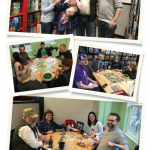He was prescribed gold therapy. “Gold was painful,” he said. He was still on gold therapy in 1990. Someone finally figured out that they could administer the gold therapy with lidocaine, helping with the pain.
When methotrexate became available to him at age 20, his rheumatologist told him it could kill him.
In 1998, “everything changed,” he said. Celecoxib, a non-steroidal anti-inflammatory drug (NSAID) and a biologic tumor necrosis factor (TNF) inhibitor, was finally part of his drug armament.
Following surgery on his hand in 1999, the subsequent pain and rehabilitation interfered with his research. He talked about having an academic mentor in his PhD program who clearly didn’t understand the debilitating effects of chronic illness and pain, but thought Kaleb should bounce back three weeks after wrist surgery like the students he knew who’d had ACL surgery.
Takeaways
While telling his story, Dr. Michaud asked questions of the rheumatologists and rheumatology professionals in the room. “How many of you look at your patients’ feet?” he asked.
Before his thumb was fused, he discussed options with his surgeon: “It was very important to have my preferences heard,” he said.
One surgery was done under local anesthetic, and he described the pain as excruciating. “It’s important to know the intensity of pain to expect and how long it will last.”
Give your patients the tools they need to take care of themselves. It took years, he said, for him to realize, “My doctor isn’t the one taking care of me. I am.”
He also shared with the audience activities that help him keep going. That list included occupational therapy, massage, mid-morning caffeine, getting at least seven or eight hours of sleep a night on a waterbed, CPAP, as well as “pet cat, play and read to kids, weekly board game.”
Using several apps, Dr. Michaud meticulously tracks his activities to ensure that he can best keep up with all the professional and personal challenges that come his way.
He concluded with what he’s looking forward to—the hope in the session title—a cure. To get there, this consummate researcher said, “We need to have evidence to know what works and what doesn’t, as much as possible. Every experience should be some sort of data point that we can learn from.”
Dr. Michaud’s Key References
Wolfe F, Michaud K. The clinical and research significance of the erythrocyte sedimentation rate. J Rheumatol. 1994 Jul;21(7):1227–1237. PMID: 7966063.

